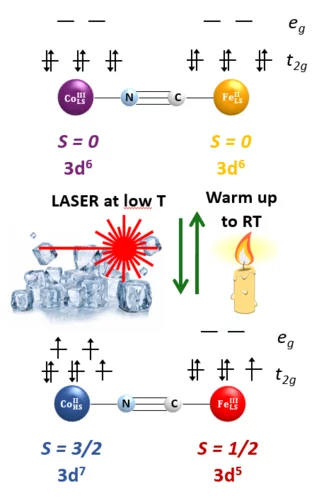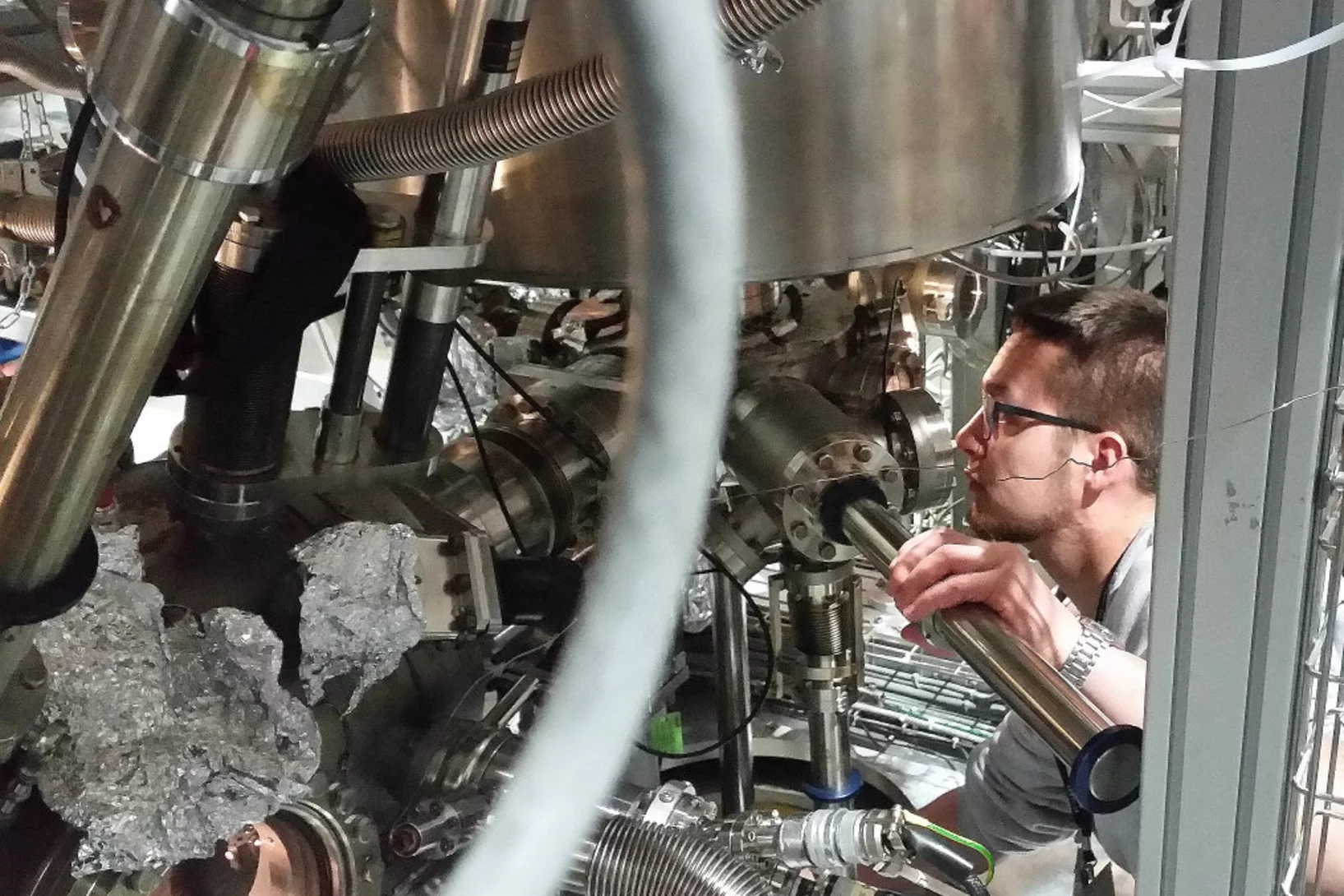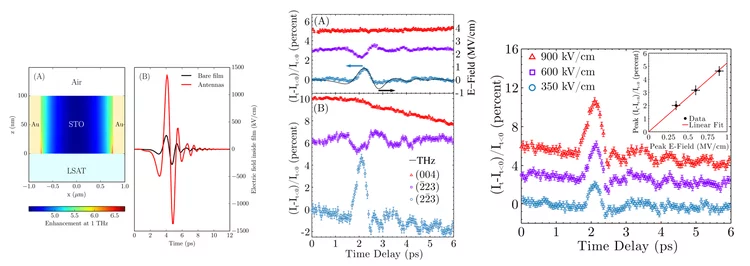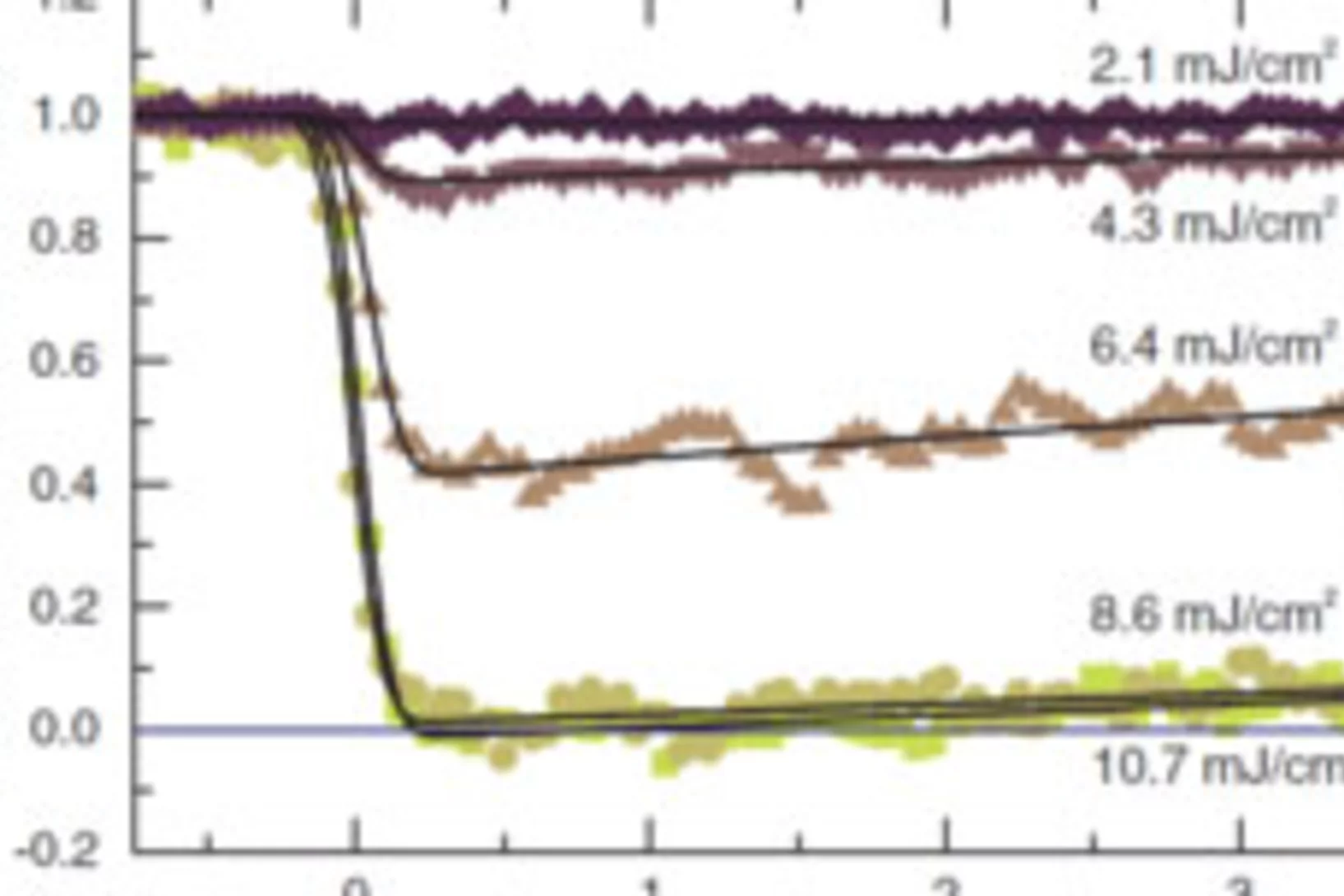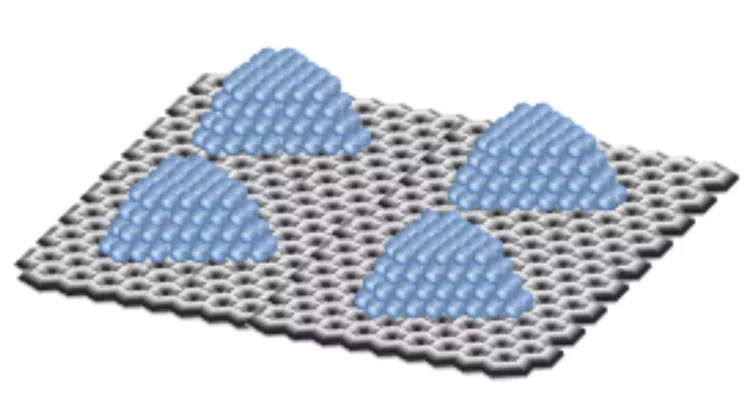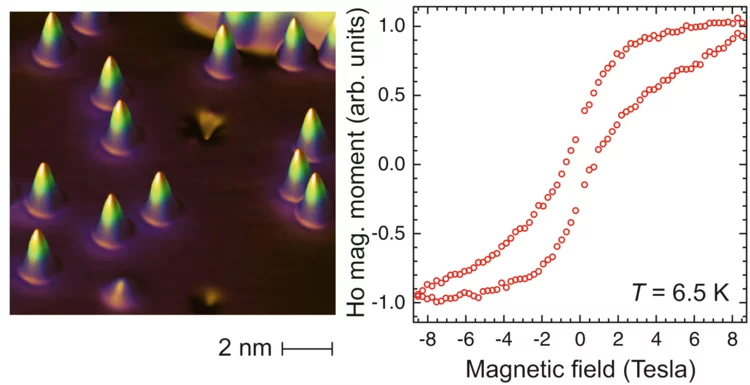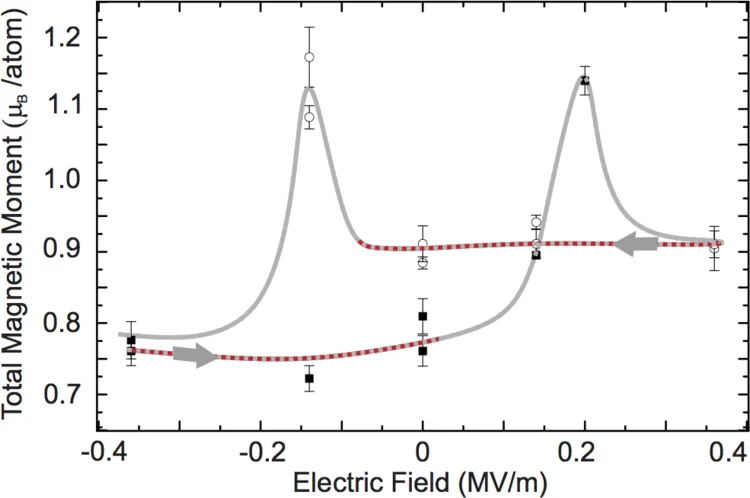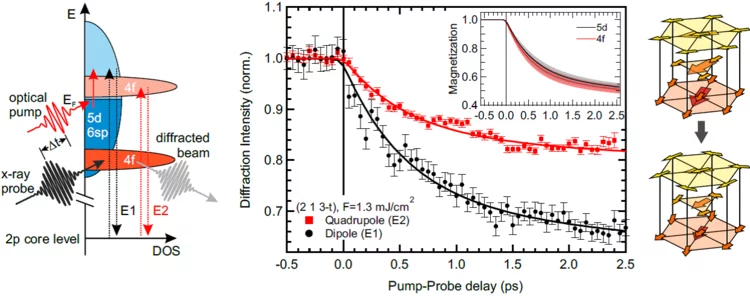Photoswitching in a Molecular Cube
Niéli’s paper is accepted in the Journal of Physical Chemistry Letters! We use X-ray absorption spectroscopy and X-ray magnetic circular dichroism to watch directly how the Co and Fe ions in a molecular cube change their oxidation states and turn from diamagnetic into paramagnetic units upon light irradiation.
New Method for Calculating Soft X-ray Magnetic Circular Dichroism Spectra
Scientists have demonstrated in a combined theoretical and experimental effort that the new ligand-field density functional theory method (LF-DFT) can be used to calculate the X-ray absorption spectra (XAS) and X-ray magnetic circular dichroism (XMCD) of lanthanide compounds from purely structural input.
Moving Atoms by Photodoping
Understanding how and how fast we can drive atoms to create a structural phase transition is of fundamental interest as it directly relates to many processes in nature. Here we show that a photoexcitation can drive a purely structural phase transition before the energy is relaxed in the material that corresponds to a “warmer” equilibrated state.
Revealing a Living-Dead Magnetic Layer
A peculiar magnetic “dead layer” is detected at the surface of thin films of DyTiO3, a ferrimagnetic Mott insulator. Depth dependent X-ray absorption measurements performed at the X-Treme beamline in the Swiss Light Source indicate that this layer is associated with a deviation of the Ti valence from 3+ toward 4+ at the film surface, suppressing the magnetic coupling between Ti ions and unleashing a strong paramagnetic response from uncoupled Dy ions.
HERCULES at the Swiss Light Source
In the week of March 18-23 PSI welcomes 20 PhD students and postdocs taking part in the HERCULES 2018 school on Neutron and Synchrotron Radiation. They will attend lectures and perform two days of practical courses at several beam lines of the Swiss Light Source.
Photoinduced transitions in magnetoresistive manganites: A comprehensive view
Using the FEMTO slicing source at SLS, we have studied the structural response during the photoinduced transition in a charge-ordered Pr1-xCaxMnO3 thin films. By investigating the dynamics of both superlattice reflections and regular Bragg peaks, we disentangle the different structural contributions and analyze their relevant time-scales. Comparing these results with studies of the charge order and magnetic dynamics, a comprehensive picture of the phase transition linked to a single critical fluence fc is proposed.
Magnetic structures take a new turn
The unexpected finding that in an ‘artificial spin ice’ magnetostatic energy can be transformed into directed rotation of magnetization provides fresh insights into such nano-patterned magnetic structures — and might enable novel applications in nanoscale devices.
L'atmosphère à la lumière des rayons X
Des chercheurs du PSI ont développé une chambre d’expérience où ils reconstituent certains processus qui se jouent dans l’atmosphère et peuvent étudier ces derniers avec une précision inégalée grâce à de la lumière de type rayons X issue de la SLS. Lors de leurs premières expériences, ils ont étudié la formation du brome, qui joue un rôle essentiel dans la dégradation de l’ozone dans les couches inférieures de l’atmosphère. A l’avenir, cette nouvelle chambre d’expérience sera également mise à disposition de chercheurs d’autres disciplines scientifiques.
Single-shot Monitoring of Ultrafast Processes via X-ray Streaking at a Free Electron Laser
The advent of x-ray free electron lasers has extended the unique capabilities of resonant x-ray spectroscopy techniques to ultrafast time scales. Here, in collaboration between researchers from PSI, Sorbonne Universités, HASYLAB/DESY, Synchrotron SOLEIL, CNRS, and Uppsala University, we report on a novel experimental method that allows retrieving with a single x-ray pulse the time evolution of an ultrafast process, not only at a few discrete time delays, but continuously over an extended time window.
Moving atoms with enhanced
THz pulses and tracking them with ultrashort x-ray pulses on an XFEL
Controlled motions of atoms using ultrashort electric field pulses allow to manipulated the properties of a material on ultrafast timescales. Here we show how metallic structures can be used to enhance a THz electric field pulse and track the induced atomic motions with ultrashort x-ray pulses emitted by a X-ray free electron laser.
Nonlinear electron-phonon coupling in doped manganites
We employ time-resolved resonant x-ray diffraction to study the insulator-to-metal transition that is launched via resonant excitation of an infrared-active optical phonon mode in a half doped manganite. We find that the charge order reduces promptly with a highly nonlinear (quartic) dependence on excitation fluence.
Carlos Vaz Honored by the American Physical Society as Outstanding Referee 2017
SIM beamline scientist Carlos Vaz was recognized as outstanding referee for providing high quality peer review for the journals of the American Physical Society (APS).
In-situ Studies of the Reactivity of Model Catalysts: Surface Chemistry from flat surfaces to nanoparticles
On 7th February Dr. Christian Papp from University Erlangen (Germany) is visiting the SIM beamline and will give a Photon Science Seminar talk with the title: "In-situ Studies of the Reactivity of Model Catalysts: Surface Chemistry from flat surfaces to nanoparticles"
Annual Retreat of the Microscopy & Magnetism Group
The Magnetism and Microscopy group has met for its annual retreat meeting in Lungern 11- 15.1.2017 (in the central mountain region of Switzerland) for extensive discussions on its science program. As for other years, after some general introductory lecture into the techniques used, current and future projects have been presented by the PhD students, postdocs, and scientists as well as from guests who collaborate with the group. Discussion went into the time where dinner has been prepared together, followed by some leisure activities on Saturday.
De nouvelles approches des réactions chimiques grâce aux nanotechnologies
80 % des produits de l’industrie chimique sont fabriqués par recours à la catalyse. Ce procédé est également indispensable dans la conversion énergétique et l’épuration des gaz d’échappement. L’industrie teste donc continuellement de nouvelles substances et de nouvelles configurations susceptibles de déboucher sur de nouveaux procédés catalytiques plus performants. Des chercheurs de l’Institut Paul Scherrer PSI à Villigen et de l’ETH Zurich ont à présent développé une méthode qui permet d’améliorer nettement la précision de tels essais, ce qui devrait accélérer la recherche de solutions optimales.
The Smallest Magnet
Single holmium atoms adsorbed on few monolayers of magnesium oxide are extraordinarily stable magnets. They retain a significant fraction of their magnetization when the external magnetic field is switched off. This has been shown recently in a study combining x-ray magnetic circular dichroism performed at the Swiss Light Source (SLS) and at the European Synchrotron Radiation Facility (ESRF) as well as scanning tunneling microscopy. The results open perspectives of storing and processing information at ultrahigh density.
Magnesium Oxide Boosts the Hysteresis of Single-Molecule Magnets
Researchers from PSI and EPFL have demonstrated that the magnetization hysteresis and remanence of TbPc2 single-molecule magnets drastically depends on the substrate on which they are deposited. If a few atomic layers thick magnesium oxide film grown on a silver substrate is used, a record wide hysteresis and record large remanence can be obtained. Single-molecule magnets are attractive for molecular spintronics applications such as information processing or storage.
Magnetoelectroelastic control of magnetism
X-ray magnetic circular dichroism at the Co L3,2 edges measured at the X-Treme beamline, SLS and at the Advanced Light Source, evidence that three distinct electric field driven remanent magnetization states can be set in the Co film at room temperature. Ab initio density functional theory calculations unravel the relative contributions of both strain and charge to the observed magnetic anisotropy changes illustrating magnetoelectroelastic coupling at artificial multiferroic interfaces.
Itinerant and Localized Magnetization Dynamics in Antiferromagnetic Holmium
Resonant magnetic scattering performed at the x-ray free electron laser facility LCLS (USA) has been used to investigate the magnetization dynamics of elemental Holmium. It is found that the demagnetization of conduction electrons and localized 4f magnetic moments have the same temporal evolution showing a strong coupling between the different magnetic moments.
Tunable spin polarization and superconductivity in engineered oxide interfaces
A new kind of 2DEG is found by inserting two atomic layers of the antiferromagnetic and insulating compound EuTiO3 between LaAlO3 and SrTiO3. The 2DEG is found to exhibit besides a superconducting ground state, a strong spin-polarization. The magnetism of Eu and Ti was studied by XMCD at the X-Treme beamline in SLS.
Excited states at interfaces of a metal-supported ultrathin oxide film
At the PEARL beamline, metal-supported ultrathin oxide films have been studied which are a class of materials of technological importance in various research fields such as catalysis, spintronics, or nanoelectronics.
Interfacial Control of Magnetic Properties at LaMnO3/LaNiO3 heterostructures
Using a X-ray magnetic circular dichroism measured at the X-Treme beamline, SLS, in conjunction with X-ray reflectivity measured at the SEXTANTS beamline, SOLEIL, the authors show that the degree of intermixing at the monolayer scale allows interface-driven properties such as charge transfer and the induced magnetic moment in the nickelate layer to be controlled.
A la recherche du plus petit bit
Si l’on veut produire à l’avenir des supports de stockage pour média toujours plus compacts, il faut que les domaines magnétiques à les bits de stockage à soient de plus en plus petits. Mais quelle est la taille minimale d’un tel aimant ? Des chercheurs de l’Institut Paul Scherrer PSI étudient les phénomènes surprenants du nanomagnétisme.
Fermi Surface of Three-Dimensional La1−xSrxMnO3 Explored by Soft-X-Ray ARPES: Rhombohedral Lattice Distortion and its Effect on Magnetoresistance
A research team led by scientists from the Swiss Light Source has for the first time established three-dimensional (3D) electronic structure of the perovskite compound La1−xSrxMnO3 connected with its colossal magnetoresistance. Instrumental for this study has been the use of the new experimental technique of soft-x-ray ARPES, available at the ADRESS beamline, with its intrinsically sharp definition of 3D electron momentum.
Reduction of Mn19 Coordination Clusters on a Gold Surface
The surface-induced changes of the oxidation state and magnetic properties of Mn ion clusters have been probed by X-ray absorption spectroscopy and X-ray magnetic circular dichroism.
Ultrafast structural dynamics of the Fe-pnictide parent compound BaFe2As2
Understanding the interplay of the various degrees of freedom such as the electrons, spins and lattice is essential for many complex materials, including the high-temperature superconductors.
Batman montre la voie vers un stockage de données plus compact
Des chercheurs de l'Institut Paul Scherrer (PSI) ont réussi à renverser l'aimantation de minuscules structures magnétiques grâce à la lumière d'un laser, et à suivre le déroulement de ce retournement au cours du temps. Une zone de quelques nanomètres a alors brièvement clignoté. Fait insolite : sa forme rappelait le logo en forme de chauve-souris de Batman. Les résultats de cette recherche pourraient rendre le stockage de données sur les disques durs plus compact, plus rapide et plus économique.
Nanoscale sub-100 picosecond all-optical magnetization switching in GdFeCo microstructure
Ultrafast magnetization reversal driven by femtosecond laser pulses has been shown to be a promising way to write information. Seeking to improve the recording density has raised intriguing fundamental questions about the feasibility of combining ultrafast temporal resolution with sub-wavelength spatial resolution for magnetic recording. Here we report on the experimental demonstration of nanoscale sub-100 ps all-optical magnetization switching, providing a path to sub-wavelength magnetic recording.
Control of Tc in La0.7Sr0.3MnO3 via piezostrain
X-ray magnetic circular dichroism measurements evidence a 10K shift of the magnetic Curie temperature for La0.7Sr0.3MnO3 deposited on the piezoelectric substrate [Pb(Mg1/3Nb2/3)O3]0.68−[PbTiO3]0.32 (011) for two different remanent piezostrain states.

